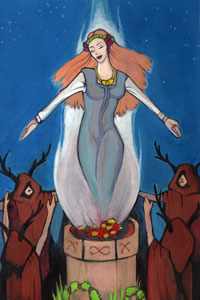 The Slavic goddess of love and beauty, who appears as Freya, Isis, or Aphrodyte with other peoples. It is, of course, linked to the planetary power of Venus who is, besides love and beauty, associated with fertility. Lada is represented as a girl with long golden hair sometimes with a wreath of ears of grain braided into her hair, which symbolises her function of fertility deity thus making her an aspect of Mother of Wet Land. A symbol of Sun, a mark of lifegiving power was sometimes on her breasts. As a fertility goddess, Lada has her annual cycles, which can be shown by the belief that she resides in the dwelling place of the dead until the vernal equinox comes. This world of the dead is called Irij, and here, besides Lada, dwells Veles, the horned god of cattle. At the moment when Lada is supposed to come out into the world and bring spring, Gerovit opens the door of Irij letting the fertility goddess bless the earth. At the end of summer, Lada returns to Irij (there is a similar myth in German mythology in which Freya spends a part of the year underground among the elves, whereas Greek Persefona dwells in Had during the winter period). Although her reign begins on the 21st of March, Lada is primarily the goddess of summer. She follows Vesna, the Slavic spring goddess. However, both of these goddesses are associated with fertility so sometimes it can sometimes be difficult to separate their functions. As we can see, Lada's reign begins in spring, the proof of which is ladenj, another name for April, given after this goddess. Apart from the Sun, Lada is also associated with rain and hot summer nights, the ideal time for paying respect to the love goddess. The Slavic goddess of love and beauty, who appears as Freya, Isis, or Aphrodyte with other peoples. It is, of course, linked to the planetary power of Venus who is, besides love and beauty, associated with fertility. Lada is represented as a girl with long golden hair sometimes with a wreath of ears of grain braided into her hair, which symbolises her function of fertility deity thus making her an aspect of Mother of Wet Land. A symbol of Sun, a mark of lifegiving power was sometimes on her breasts. As a fertility goddess, Lada has her annual cycles, which can be shown by the belief that she resides in the dwelling place of the dead until the vernal equinox comes. This world of the dead is called Irij, and here, besides Lada, dwells Veles, the horned god of cattle. At the moment when Lada is supposed to come out into the world and bring spring, Gerovit opens the door of Irij letting the fertility goddess bless the earth. At the end of summer, Lada returns to Irij (there is a similar myth in German mythology in which Freya spends a part of the year underground among the elves, whereas Greek Persefona dwells in Had during the winter period). Although her reign begins on the 21st of March, Lada is primarily the goddess of summer. She follows Vesna, the Slavic spring goddess. However, both of these goddesses are associated with fertility so sometimes it can sometimes be difficult to separate their functions. As we can see, Lada's reign begins in spring, the proof of which is ladenj, another name for April, given after this goddess. Apart from the Sun, Lada is also associated with rain and hot summer nights, the ideal time for paying respect to the love goddess.
Lada's animals are a cock, a deer, an ant and an eagle, whereas her plants are a cherry, a dandelion, a linden and a peony. Besides Venus, Lada is connected with the constilation of Taurus, which Aleksandar Asov wrote about in The Slavic Astrology. Here, we can once again see here her function of fertility goddess, whose reign begins in spring, mix with the function of the goddess Vesna. A myth says that Lada is married to Svarog who is only with her help able to create the world. According to another one, she is a companion of Jarilo, thus associated with Aphrodyte, whose lover is Ares. Rituals performed in Lada's honour are most often linked with contracting marriages, or choosing a spouse. One of the known rites is ladarice, also performed under the name of kraljice in Serbia. Vuk Karadžić described the basic characteristics of this ritual. On Holy Trinity Day, a group of about ten young girls gathers, one of them is dressed like a queen, another one like a king, and another one like a colour-bearer. The queen is sitting on a chair, while the other girls are dancing around her, and the king and the colour-bearer are dancing on their own. In this way the queens go from house to house looking for girls of marriageable age. Jumping over the fire is another characteristic of rituals performed in Lada's honour. This custom existed in all parts of Europe and its purpose was to ensure fertility as well as to protect people and cattle from evil forces.
Vesna Kakaševski
translated by Jelena Salipurović
|

